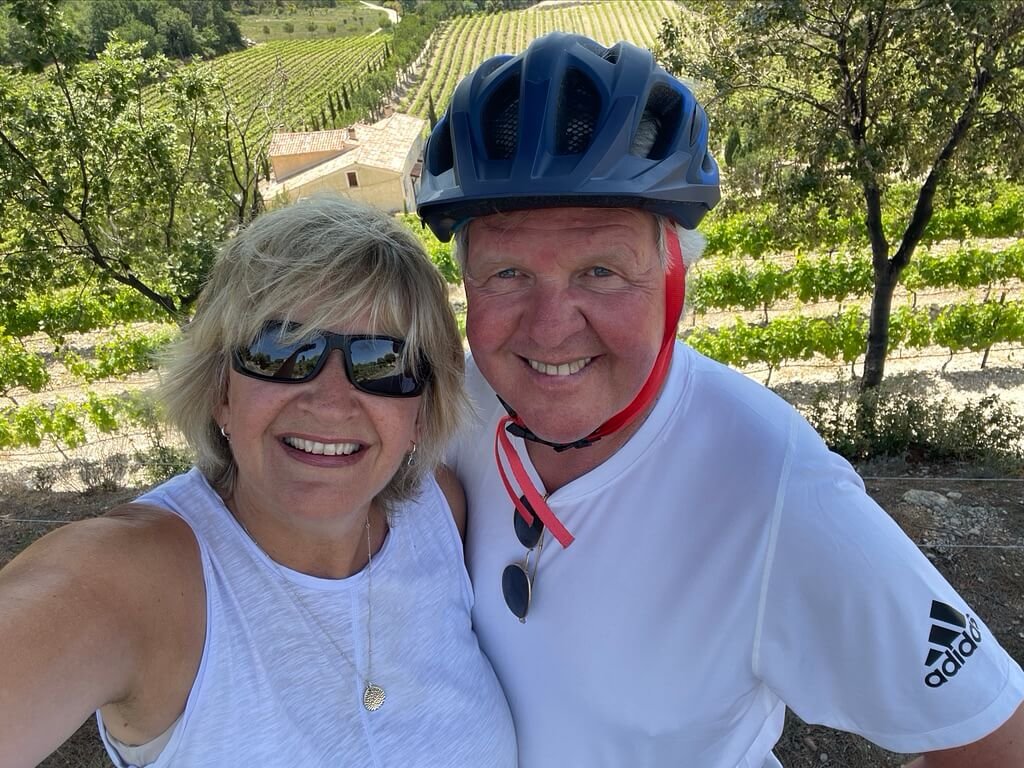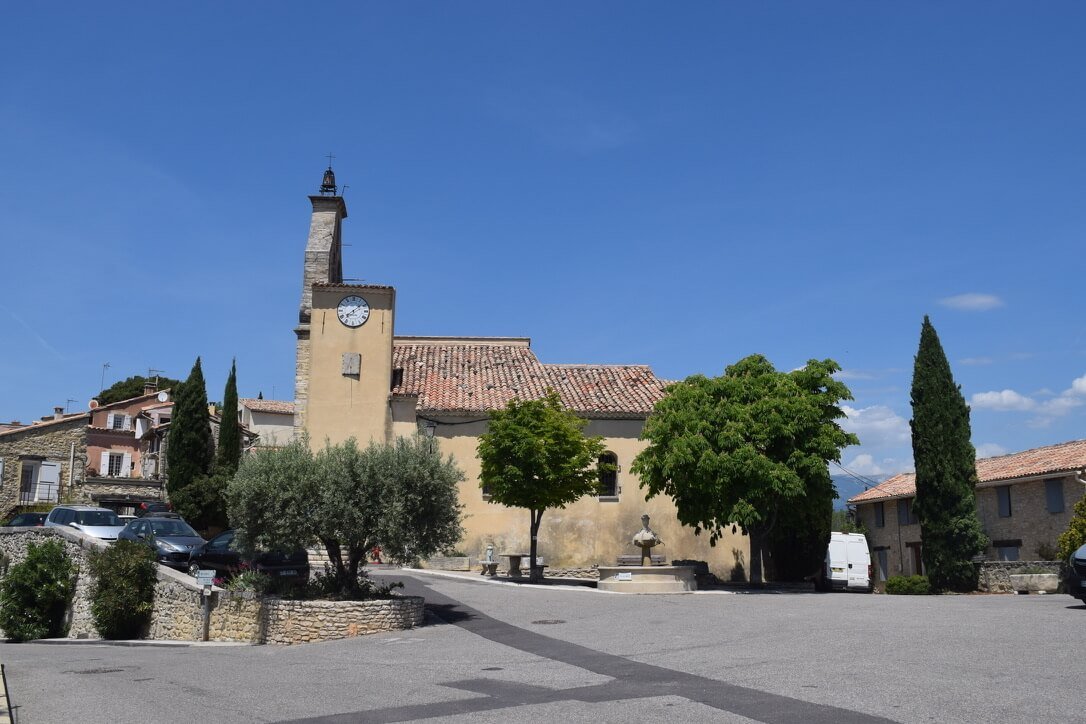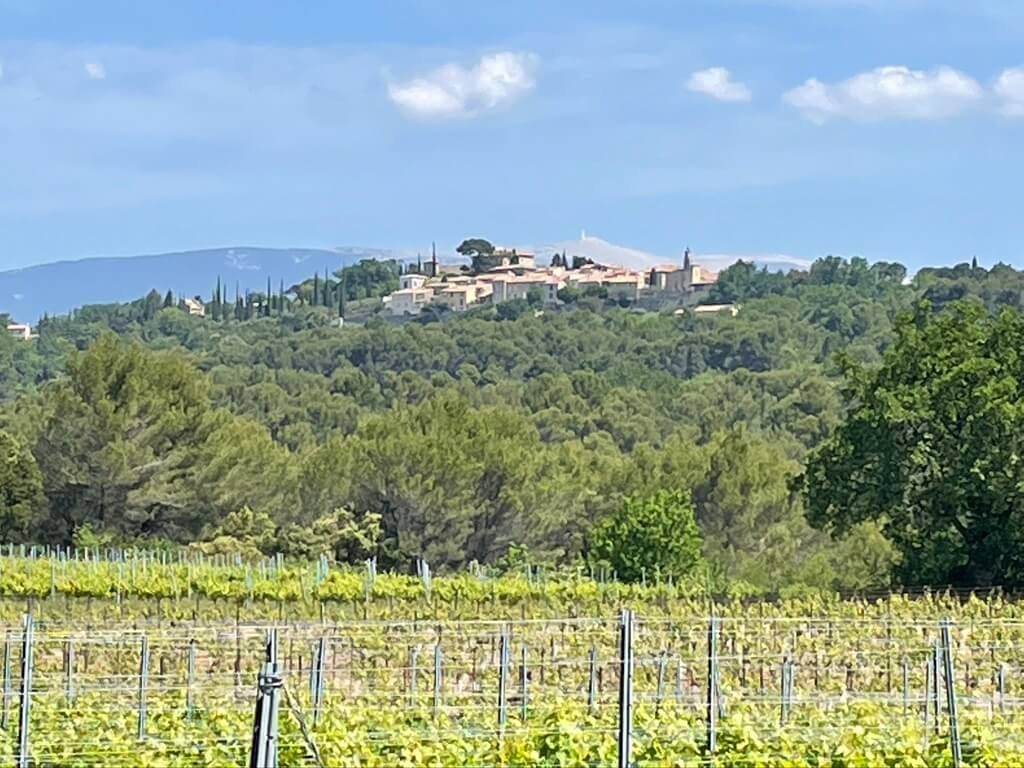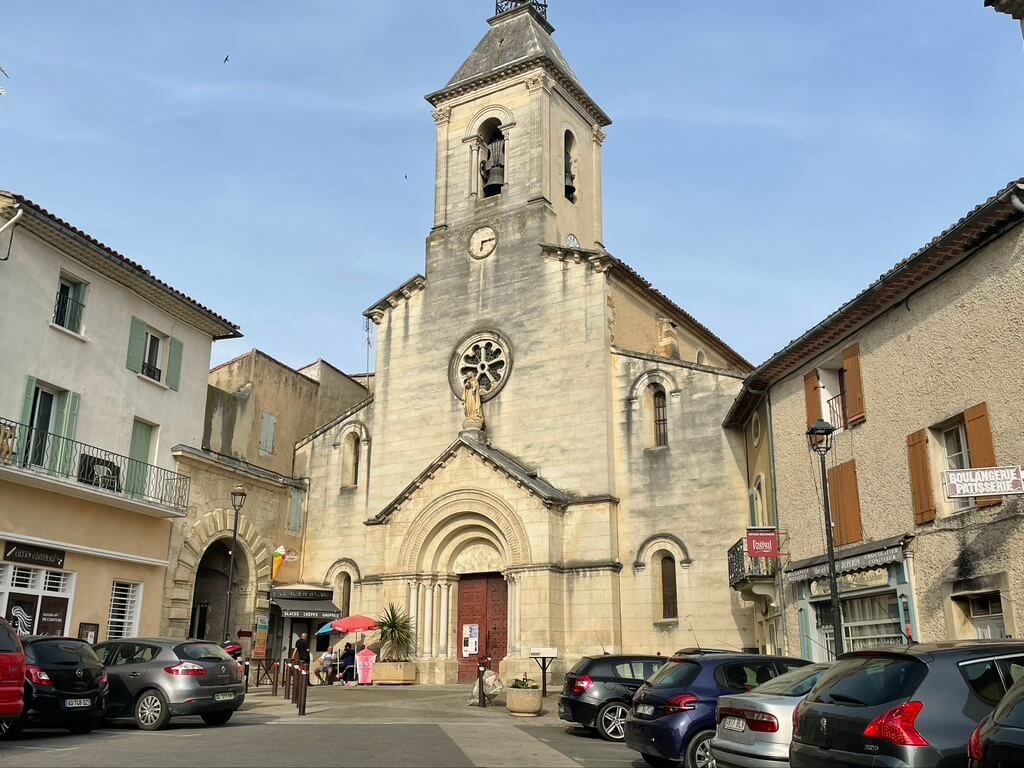Discover Mont Ventoux and Ventoux wines
Mont Ventoux in Provence is famous for presenting the greatest challenge to Tour de France cyclists, but what do you know about Ventoux wines?
Vineyards in the foothills of beautiful Mont Ventoux - Source: Wine Keller
Mont Ventoux is the highest mountain by far in Western Provence, France and is also one of its greatest landmarks, especially in the sporting world. Mont Ventoux plays a starring role in the world’s greatest cycling event, the ‘Tour de France’, presenting its fiercest challenge to cyclists and a great spectacle for all following the event at home.
However, not many people probably realise that this wine region, called simply ‘Ventoux’, is one France’s most exciting wine regions and Mont Ventoux plays a key role here too.
Learn below why Ventoux is getting the wine world very excited and also why you should visit it and explore!
Also see our video here:
Where is the Ventoux wine region?
Ventoux is a large wine region in the far southeast of the southern Rhône, spread out along the lower slopes of Mont Ventoux.
It is located 40 km northeast of Avignon, in the French départment of Vaucluse. It’s an AOC of the French Rhône Valley wine region, but is included in the Provence administrative region.
It is bordered in the south by the Luberon wine region and to the north, the famous wine regions of Beaumes de Venise, Gigondas, Vacqueyras, Cairanne, Rasteau and Côtes du Rhône Villages.
This is a region which attracts winemakers and wine lovers alike, but also tourists and cyclists!
Southern Rhône wine map
Cycling up to the summit of Mont Ventoux
Mont Ventoux
From almost anywhere in the southern Rhône, you can see the distinctive limestone cap of Mont Ventoux, which in fact looks like snow, rather than limestone from a distance. This beautiful mountain, often referred to as the ‘Giant of Provence’, looks down over the wine-producing areas of the Rhône Valley to the west and Provence to the south and east.
Mont Ventoux is located some 20km northeast of the town of Carpentras and stands alone from the Alps mountain range, albeit a part of it, towering majestically over the landscape for miles around. It stands alone to the north of the Luberon mountain range, separated by the Monts de Vaucluse and just to the east of the Dentelles de Montmirail, its foothills. Its highest point is just over 1900 metres.
As the name suggests - ‘vent’ meaning ‘wind’ in French - it can get extremely windy on the mountain, especially on the summit, which is often closed due to high winds.
Cycling Mont Ventoux
Mont Ventoux can be ascended by road bike via 3 separate routes and the most challenging ascent has an average gradient of over 7% - this is for serious cyclists!
There are several different road cycling competitions which just focus on Mont Ventoux, but undoubtedly the most famous cycle race to feature this famous and gruelling challenge is the Tour de France.
Mont Ventoux has featured in the Tour de France about 20 times and the race has actually finished at the Mont Ventoux summit 10 times. There is a memorial to a British cyclist, Tom Simpson, who died from heat exhaustion on the mountain during the race in 1967.
Many amateur cyclists flock to Mont Ventoux to test themselves against its gruelling ascents, but the foothills also provide fun and challenge to cyclists of all abilities (including ourselves - see later!).
Tour de France route, 2021
The Ventoux AOC wine region
The Ventoux appellation - or AOC - was formerly known as Côtes de Ventoux, from its inception in 1973 up until October 2009, when the name was simplified and today it covers 51 different communes in the Vaucluse region.
There are about 8000 hectares of vineyards spread out on the western slopes and foothills of Mont Ventoux, across an area covering 50km from north to south, bordering with the Luberon wine region on its southern border. Ventoux is the only AOC situated at the heart of two nature reserves - Ventoux and Luberon. It is also a UNESCO Biosphere Reserve.
What makes Ventoux stand out from other southern Rhône wine regions?
Ventoux has been through many changes over the last 20 years, not just a name change. Many new winemakers have established themselves here, deploying new techniques, focusing on sustainability and experimenting with different styles of wines.
The principal factor attracting new winemakers to the region and causing excitement about Ventoux wines in the wine world, is the climate.
Ventoux enjoys a very particular micro-climate, which specifically causes large variations between day and night-time temperatures. This, along with the fact that the vines are grown at relatively high altitude, makes it unique compared to its southern Rhône neighbouring wine regions and enables it to produce very different wines. The temperature variation effectively slows down the growing season, with the harvest taking place well into October, allowing the grapes to benefit and to produce lighter and more fruit-driven wines.
Ventoux wines
The Ventoux is one of the oldest wine regions in France, with vines being grown here since the 1st century BC! Ventoux wines are mostly red and rosé, with a few whites and the grape varieties are consistent with those grown across the southern Rhône region.
Ventoux red wines:
The classic southern Rhône red grape varieties of Grenache, Syrah and Mourvèdre are used in most of the wines, with Cinsault, Marselan and Carignan also used. The red blends feature an intense ruby colour and aromas of red fruit, spices, leather, liquorice and truffles. The rosés are elegant and refreshing, with a good length of flavour and notes of cherries, raspberries and flowers.
Ventoux white wines:
The white wines are made from Clairette, Bourboulenc, Rolle (Vermentino), Viognier and Grenache Blanc, with the occasional use of Roussanne. They are typically golden-coloured, with scents of citrus fruits, hawthorn and acacia.
Grapes grow so well in Ventoux that the Muscat table grapes have their own AOC, called ‘Muscat du Ventoux’.
Ventoux wines - one to watch
Ventoux wines have historically been cheaper than other more famous southern Rhône wines and land in the Ventoux region has not been so expensive. This has made Ventoux wines a great option for both quality and value. However, due to climate change factors and the influx of new winemakers into Ventoux, their wines will soon be in high demand and prices will rise - so watch out and get in quick!
Stunning Mont Ventoux and its foothills - Source: Wine Keller
Ventoux winemakers and wineries
There are some 150 wineries in Ventoux. Some use the local co-operatives to help produce their Ventoux wines and some have established themselves as great Ventoux wine producers and leading lights of this exciting Rhône Valley wine region.
Here are a few whose wines are definitely worth trying and whose estates are definitely worth visiting!
Château Pesquié - situated in the foothills of Mont Ventoux, a family-run estate at and one of the Ventoux appellation’s leading lights (see later)
Domaine de Fondrèche - 40 hectares of vineyards spread out across the communes of Mazan, Mormoiron and Saint Pierre de Vassols - organic and biodynamic - excellent reputation for quality
Chene Bleu (named after the huge blue oak tree on the estate) and the property Domaine de La Verrière - organic and biodynamic - one of the highest vineyards in Vaucluse and the South of France at 600m altitude - earned respect for quality
Château Unang - a beautiful estate with 40 hectares of forest and 20 hectares of vineyards surrounding one of the oldest castles of the Vaucluse area - Visit the estate for wine tastings, wine and cheese, picnics, walks and château visits!
More information about wineries around the Ventoux area.
View over Ventoux vineyards from the village of Blauvac
Our visit to Ventoux wine estate, Château Pesquié
During our day exploring the Ventoux and following a bit of research, we booked a tasting at Château Pesquié, one of the leading lights in Ventoux winemaking and by all accounts, a stunning château and scenery!
Located at the foot of the magnificent Mont Ventoux and at the heart of the Mont Ventoux Regional Natural Park, locations don’t get more stunning than this one! As we drove up the long driveway, surrounded by vines, a beautiful French Provençal château in front of us and the incredible Mont Ventoux towering behind it, we were suitably impressed!
Some background about Château Pesquié
Château Pesquié is a family-run wine estate and 3 generations of the Chaudière family, who own the 18th century château, have put all of their passion over 50 years into exploring how to fully express the incredible terroir of AOC Ventoux.
Since 2003, Alexandre and Frédéric Chaudière have been managing the estate and today Château Pesquié is one of the flagship wineries of the Ventoux appellation and the southern Rhône Valley, The 2 brothers also managed the transition of the estate and the farming of the vines, which are on average 40 years old, to organic, starting in 2007and biodynamic from 2015. In fact, the whole philosophy of the estate is built around sustainability.
Château Pesquié is situated in the latest-ripening part of Ventoux - one of the highest and latest-ripening terroirs of the southern Rhône Valley and this is what guarantees the finesse and elegance of its wines. The winery is nestled between three villages: Mormoiron, Blauvac and Ville-sur-Auzon. The vineyards, which have an average altitude of 300-400 metres, are warmed during the day by the sun on the southern slopes of Mont Ventoux and the mountain temperatures ensure a cooling effect at night. The Mistral winds also act as a drying effect for any rain.
Château Pesquié wines
The estate is able to grow 12 different grape varieties, however there are 2 dominant varieties - 40% of vines are Grenache, (typical of the southern Rhône) and 30% are Syrah (typical of the northern Rhône, but able to flourish here due to the unique location and micro-climate).
The other varieties grown are Cinsault, Carignan, Mourvèdre, Marselan, Roussanne, Viognier, Clairette, Grenache blanc, Bourboulenc and Chardonnay.
Château Pesquié produces an extensive range of wines, mainly cuvées, produced for both easy drinking and enjoying with food, featuring light and more complex wines, special wines made from the best vineyard parcels and also some single varietals.
There is a selection of single vineyard cuvées, which demonstrate the diversity of the terroir at Château Pesquié, including ‘Silica’, ‘Artemia’, ‘Ascensio’ and ‘Juliette’. Then there is the ‘Terrasses’ cuvées - blends of different soils and varietals present throughout the estate and the ‘Quintessence’ range - a rich and complex wine and a trademark of the Château Pesquié style.
The family has also developed a range of typically Provençal wines under the name Le Paradou.
Our visit and wine tasting at Château Pesquié
We enjoyed a tasting of 8 different wines, including the Terrasses blanc, rosé and rouge, the Quintessence wines, again in all 3 styles and 2 Le Paradou wines, the rosé blend and the Vermentino (Rolle).
We were very impressed with the wines we tasted and it really made us want to discover more about Ventoux wines.
After the tasting we were taken on a tour of the impressive winery which is built into the hillside, below ground, covered by a layer of soil and plants. Not only does this help the temperature stay cool in the cellars, it is fully integrated into the environment. All other buildings are covered in solar panels which produce more than enough electricity for the estate.
Once we had completed our tour of the winery and cellars, we had and time to wander round the fully stocked shop, with lots of great gifts and wine accessories, as well as wine of course!
We then enjoyed a lovely wine trail around the vineyards and the olive and mulberry trees, following the ‘winemaker’s path’ or the ‘sentier vigneron’ with the help of a self-guided tour booklet.
Château Pesquié has really embraced wine tourism - you can enjoy tastings, guided tours, walking trails in the vineyards, picnics in the grounds of the château and even workshops and seminars! There’s a great deal to discover and enjoy here and we would really recommend a visit to this wonderful estate in its fabulous setting. As usual, you need to book in advance so as not to be disappointed.
Where to find Château Pesquié
Address: Château Pesquié, 1365 Bis Route de Flassan, 84570 Mormoiron, France
Where to find Château Pesquié wines
You can purchase Château Pesquié wines in the UK, through The Wine Society, The Good Wine Shop and in the US, European Cellars.
Ventoux Travel Guide
Ventoux is a wonderful destination for nature lovers and sports enthusiasts! Take it from us, there’s lots to see, enjoy and appreciate!
Enjoying the Ventoux landscapes
When to visit Ventoux
As for anywhere else in the Mediterranean, Provence or South of France it’s always best if you can avoid the crowded, high Summer months! Late Spring and early Autumn are lovely times to visit this part of the world.
Where to stay in Ventoux
Here are some accommodation options for Vaucluse. Also of course try Airbnb. We stayed at Terre de Bacchus in Vacqueyras which we absolutely loved.
How to get to Ventoux
The closest international airports to Ventoux and the Vaucluse region of Provence are Marseilles and Nîmes. Avignon airport is even closer, but only has internal flights. You will need a car to explore Ventoux, so if you’re flying or perhaps taking the train (TGV link from Paris), you will need to hire a car and pick up in Avignon. The closest town and train link is Carpentras.
Hiking in the Ventoux
As mentioned earlier, Mont Ventoux and its foothills - or terraces - is classified as a UNESCO Biosphere Reserve and this incredible countryside just has to be experienced! There are many fantastic hiking trails to enjoy for all levels of hikers.
Make time to also see and experience the nearby beautiful jagged peaks of the Dentelles de Montmirail. There are numerous walking and hiking routes here which enable you to really enjoy these amazing, natural landscapes. This is also the home of renowned Rhône wines - Beaumes de Venise, Gigondas and Vacqueyras.
Cycling the foothills and terraces of Mont Ventoux
We wanted to do some cycling whilst exploring Ventoux - not to be confused with cycling up Mont Ventoux! We definitely didn’t do that!
We decided to cycle a route from ‘La Provence a Velo’, which has lots of different cycle routes all over Provence and their leaflets can be found in most tourist offices. We chose the route ‘Les Terraces de Ventoux’ - or - ‘The terraces of Mont Ventoux’!
We drove by car to the beautiful hilltop village of Méthamis in the foothills of Mont Ventoux where we joined the marked cycle route through the vineyards, olive trees and cherry orchards to the village of Malemort-du-Comtat. From here we climbed up to the stunning village of Blauvac where we had a rest and enjoyed the amazing views - on one side towards Luberon and the Monts de Vaucluse and on the other, the incredible Mont Ventoux.
We had a fabulous time exploring these small Provençal villages and enjoying the superb scenery and spectacular views. We would really recommend doing this. Here are some other cycling suggestions for the foothills and terraces of Mont Ventoux and some other cycling routes in Vaucluse.
Bike hire near Mont Ventoux
If you don’t have your own bikes you can also hire. We recommend you enquire at the main tourist office for the Ventoux region, in Carpentras - Office de Tourisme Intercommunal, Ventoux-Provence, 374 Av. Jean Jaurès, 84200 Carpentras, Tel- 04 90 63 00 78
Driving up Mont Ventoux
Don’t miss seeing the amazing views from the Mont Ventoux summit. Sunsets and sunrises are, of course, spectacular! You can drive to the summit of Mont Ventoux from either Malaucène or Saint Estève via the D974, or from Sault via the D164.
Visit Carpentras and Ventoux villages
Carpentras is the main town in Ventoux and is definitely worth visiting - especially on a Friday - market day.
Amongst the beautiful countryside there are plenty of lovely villages to explore, including 11 hilltop villages! Make sure to visit the hilltop village of Sault, situated on a rocky cliff overlooking the Sault plateau and valley, famous for lavender production! Visit in June and July and witness the fabulous purple lavender fields.
As mentioned earlier, we really enjoyed cycling round the beautiful villages in the foothills of Mont Ventoux, especially Blauvac and Méthamis.
Here is some more information about exploring the great outdoors around Mont Ventoux:
Other Rhone valley wine regions to explore
The beauty of spending time in the southern Rhône region is that you can combine several distinct wine appellations in one trip. We did just this and were able to visit many well-known Rhône Valley vineyards and regions in the space of a week. Places like Châteauneuf-du-Pape, Luberon, Gigondas, Vacqueyras, Cairanne, Rasteau, Beaumes-les-Venise are all within easy reach of Ventoux.
Traditional food and local dishes
The Ventoux region enjoys all of the wonderful cuisine, gastronomy and traditional dishes of Provence of course. However it is known in particular for its fresh fruit, including strawberries, red cherries, apricots and black figs, which grow in abundance in the area. Ventoux is also popular for black truffles - another Provencal staple - and white asparagus!
Learn more about traditional Ventoux foods here.
Ventoux markets
Visit the traditional Provencal markets of the Ventoux to experience the local foods and delicacies.
Best restaurants in Ventoux
See here for some ideas on great restaurants in the Ventoux area.
Conclusion and personal highlights
The Rhône’s Ventoux wine region was a real discovery for us! The wines are really exciting and the scenery is simply jaw-dropping! Mont Ventoux is so dramatic and wherever you are it seems to be looking down over you. We really appreciated the focus on sustainable farming and the environment here - it all feels so healthy and so untouched, despite the growing number of visitors! Let’s hope it stays that way!
Our visit to Château Pesquié was excellent and if you get the chance to visit and enjoy cycling - then get in the saddle! It will be worth it!
























